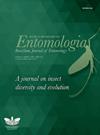Diversity and spatio-temporal variation of Anopheles (Diptera: Culicidae) before and after the construction of the Jirau hydroelectric plant, state of Rondônia, Brazil
IF 0.7
4区 农林科学
Q4 ENTOMOLOGY
引用次数: 0
Abstract
ABSTRACT The objective of this study was to evaluate the effect of the construction of the Jirau hydroelectric plant on the anopheline species, in Porto Velho, Rondonia, Brazil. For this, sampling was carried out in 23 locations in the pre (2004) and 23 after construction (2018) phases in the hydroelectric dam's coverage area, performed by human landing catch between 6:00 pm and 10:00 pm. We found 14 anopheline species. In the pre-construction phase, An. darlingi (73%) was the most abundant and after construction An. braziliensis (31.5%) was the most abundant. The T test indicated that there were no differences in the indexes – diversity (H '), richness (Sjack 1), equitability (J’) and dominance (d) of anophelines species - evaluated between the phases (p > 0.05). The spatio-temporal distribution of An. darlingi proved to be wide, with the highest density values observed in March (x¯w = 27.1) in the pre-construction phase and in the months of May (x¯w = 4) and July (x¯w = 3.1), post-construction. Differences in hematophagic activity peaks were observed between species and between phases. According to the data obtained in this study, the construction of the hydroelectric plant had little influence on the composition of anopheline species, however changes were observed in the spatio-temporal distribution of the An. darlingi and in the pattern of hematophagic activity of the species, which directly influenced the dynamics of malaria in the region.巴西朗多尼亚州吉劳水电站建设前后按蚊的多样性和时空变化
摘要本研究的目的是评估吉劳水电站建设对巴西朗多尼亚Velho港按蚊物种的影响。为此,在水电站大坝覆盖区的施工前(2004年)和施工后(2018年)的23个地点进行了采样,在下午6点至10点之间进行了人类着陆捕获。我们发现了14种按蚊。在施工前阶段,达林安(73%)最为丰富,施工后巴西安(31.5%)最为充足。T检验表明,各阶段评价的按蚊物种多样性(H’)、丰富度(Sjack 1)、等位性(J’)和优势度(d)指标没有差异(p>0.05),在施工前阶段的3月(x’w=27.1)以及施工后的5月(x‘w=4)和7月(x”w=3.1)观察到的最高密度值。在物种之间和阶段之间观察到噬血活性峰值的差异。根据本研究中获得的数据,水电站的建设对按蚊物种的组成影响不大,但观察到该物种的时空分布和吸血活动模式发生了变化,这直接影响了该地区疟疾的动态。
本文章由计算机程序翻译,如有差异,请以英文原文为准。
求助全文
约1分钟内获得全文
求助全文
来源期刊
CiteScore
1.50
自引率
12.50%
发文量
14
审稿时长
6-12 weeks
期刊介绍:
Information not localized

 求助内容:
求助内容: 应助结果提醒方式:
应助结果提醒方式:


